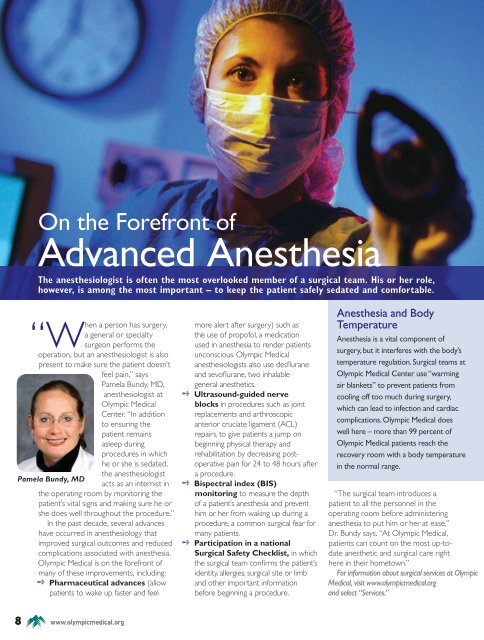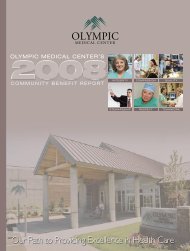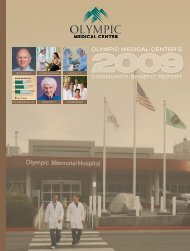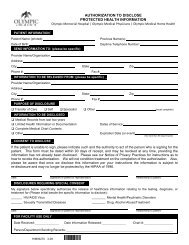the Hospital of Today - Olympic Medical Center
the Hospital of Today - Olympic Medical Center
the Hospital of Today - Olympic Medical Center
Create successful ePaper yourself
Turn your PDF publications into a flip-book with our unique Google optimized e-Paper software.
On <strong>the</strong> Forefront <strong>of</strong><br />
Advanced Anes<strong>the</strong>sia<br />
The anes<strong>the</strong>siologist is <strong>of</strong>ten <strong>the</strong> most overlooked member <strong>of</strong> a surgical team. His or her role,<br />
however, is among <strong>the</strong> most important – to keep <strong>the</strong> patient safely sedated and comfortable.<br />
a person has surgery,<br />
a general or specialty<br />
“When<br />
surgeon performs <strong>the</strong><br />
operation, but an anes<strong>the</strong>siologist is also<br />
present to make sure <strong>the</strong> patient doesn’t<br />
feel pain,” says<br />
Pamela Bundy, MD,<br />
anes<strong>the</strong>siologist at<br />
<strong>Olympic</strong> <strong>Medical</strong><br />
<strong>Center</strong>. “In addition<br />
to ensuring <strong>the</strong><br />
patient remains<br />
asleep during<br />
procedures in which<br />
he or she is sedated,<br />
<strong>the</strong> anes<strong>the</strong>siologist<br />
Pamela Bundy, MD<br />
acts as an internist in<br />
<strong>the</strong> operating room by monitoring <strong>the</strong><br />
patient’s vital signs and making sure he or<br />
she does well throughout <strong>the</strong> procedure.”<br />
In <strong>the</strong> past decade, several advances<br />
have occurred in anes<strong>the</strong>siology that<br />
improved surgical outcomes and reduced<br />
complications associated with anes<strong>the</strong>sia.<br />
<strong>Olympic</strong> <strong>Medical</strong> is on <strong>the</strong> forefront <strong>of</strong><br />
many <strong>of</strong> <strong>the</strong>se improvements, including:<br />
➺ Pharmaceutical advances (allow<br />
patients to wake up faster and feel<br />
more alert after surgery) such as<br />
<strong>the</strong> use <strong>of</strong> prop<strong>of</strong>ol, a medication<br />
used in anes<strong>the</strong>sia to render patients<br />
unconscious. <strong>Olympic</strong> <strong>Medical</strong><br />
anes<strong>the</strong>siologists also use desflurane<br />
and sev<strong>of</strong>lurane, two inhalable<br />
general anes<strong>the</strong>tics.<br />
➺ Ultrasound-guided nerve<br />
blocks in procedures such as joint<br />
replacements and arthroscopic<br />
anterior cruciate ligament (ACL)<br />
repairs, to give patients a jump on<br />
beginning physical <strong>the</strong>rapy and<br />
rehabilitation by decreasing postoperative<br />
pain for 24 to 48 hours after<br />
a procedure.<br />
➺ Bispectral index (BIS)<br />
monitoring to measure <strong>the</strong> depth<br />
<strong>of</strong> a patient’s anes<strong>the</strong>sia and prevent<br />
him or her from waking up during a<br />
procedure, a common surgical fear for<br />
many patients.<br />
➺ Participation in a national<br />
Surgical Safety Checklist, in which<br />
<strong>the</strong> surgical team confirms <strong>the</strong> patient’s<br />
identity, allergies, surgical site or limb<br />
and o<strong>the</strong>r important information<br />
before beginning a procedure.<br />
Anes<strong>the</strong>sia and Body<br />
Temperature<br />
Anes<strong>the</strong>sia is a vital component <strong>of</strong><br />
surgery, but it interferes with <strong>the</strong> body’s<br />
temperature regulation. Surgical teams at<br />
<strong>Olympic</strong> <strong>Medical</strong> <strong>Center</strong> use “warming<br />
air blankets” to prevent patients from<br />
cooling <strong>of</strong>f too much during surgery,<br />
which can lead to infection and cardiac<br />
complications. <strong>Olympic</strong> <strong>Medical</strong> does<br />
well here – more than 99 percent <strong>of</strong><br />
<strong>Olympic</strong> <strong>Medical</strong> patients reach <strong>the</strong><br />
recovery room with a body temperature<br />
in <strong>the</strong> normal range.<br />
“The surgical team introduces a<br />
patient to all <strong>the</strong> personnel in <strong>the</strong><br />
operating room before administering<br />
anes<strong>the</strong>sia to put him or her at ease,”<br />
Dr. Bundy says. “At <strong>Olympic</strong> <strong>Medical</strong>,<br />
patients can count on <strong>the</strong> most up-todate<br />
anes<strong>the</strong>tic and surgical care right<br />
here in <strong>the</strong>ir hometown.”<br />
For information about surgical services at <strong>Olympic</strong><br />
<strong>Medical</strong>, visit www.olympicmedical.org<br />
and select “Services.”<br />
8 www.olympicmedical.org











